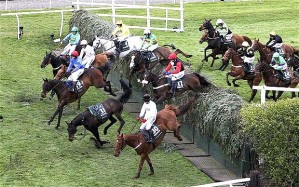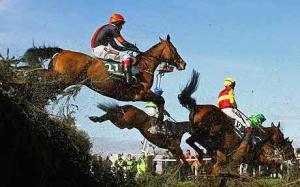 As sporting highlights go, only a few can match the sheer pleasure of forty horses thundering towards a fence at Aintree for the Grand National. This historic race always provides a story, and it is the ultimate test of skill and endurance for both jockey and horse, since their pairing have to navigate thirty treacherous fences, and reserve enough stamina for making a challenge during run-ins. Majority of these fences, including the Cana Turn, the Chair, and Becher’s Brook, are famous in their own right. These, coupled with intense distance of the race, create the ultimate test of rider and horse. Managing a clear round is no mean triumph, with fences offering matchless challenges and notoriously difficult. Grand National is held every year in Liverpool at Aintree Racecourse and it has never failed to a attract multitudes of crowds. During the years, memorable moments have been countless, the phantom leap of the Devon Loch during the 1956 contest, the 1967 shock Foinavon’s 100-1 win, not forgetting the brilliant Red Rum, which the chase in three different occasions in 1973, 1974, and 1977.
As sporting highlights go, only a few can match the sheer pleasure of forty horses thundering towards a fence at Aintree for the Grand National. This historic race always provides a story, and it is the ultimate test of skill and endurance for both jockey and horse, since their pairing have to navigate thirty treacherous fences, and reserve enough stamina for making a challenge during run-ins. Majority of these fences, including the Cana Turn, the Chair, and Becher’s Brook, are famous in their own right. These, coupled with intense distance of the race, create the ultimate test of rider and horse. Managing a clear round is no mean triumph, with fences offering matchless challenges and notoriously difficult. Grand National is held every year in Liverpool at Aintree Racecourse and it has never failed to a attract multitudes of crowds. During the years, memorable moments have been countless, the phantom leap of the Devon Loch during the 1956 contest, the 1967 shock Foinavon’s 100-1 win, not forgetting the brilliant Red Rum, which the chase in three different occasions in 1973, 1974, and 1977.
In 1981, Bob and Aldaniti completed an emotional tale when winning the race following the later recovery from a career-threatening injury, while jockey Champion was just from battling cancer. Another fairytale story was during the 2011 Grand National where Donald McCain emulated Ginger, the Aintree Legend and his father, following a win with Ballabriggs, which just came a year subsequent to champion jockey McCoy al last became a victor after fifteen time of asking.
The race is run at Aintree over the National Course and consists of two sixteen-fences circuit, with the fist fourteen being jumped twice. Of any  Britain National Hunt, this is the longest race, requiring participants to cover a distance of 4 miles and 3 1/2 furlongs. Following the 2012 event, as part of safety appraisal, the start was moved ninety yards from the grandstands and crowds reducing the racing distance from the historic 4 miles and 3 1/2 furlongs. Many people get in on the fun by betting on the race through sites like http://www.free-grandnationalbet.co.uk. The course is prominent for its longest run-ins at 494 yards from the ultimate fence. Initially, when the race was officially launched in 1839, it was designed as a national cross-county steeplechase. The race started a lace just on the edge of the racing course and went away from the course to the open country side en route for the Leeds and Liverpool Canal. The hedges, gates, and ditches met on the way were flagged to provide jumping obstacles with rails and posts erected to runners with a jumping brook.
Britain National Hunt, this is the longest race, requiring participants to cover a distance of 4 miles and 3 1/2 furlongs. Following the 2012 event, as part of safety appraisal, the start was moved ninety yards from the grandstands and crowds reducing the racing distance from the historic 4 miles and 3 1/2 furlongs. Many people get in on the fun by betting on the race through sites like http://www.free-grandnationalbet.co.uk. The course is prominent for its longest run-ins at 494 yards from the ultimate fence. Initially, when the race was officially launched in 1839, it was designed as a national cross-county steeplechase. The race started a lace just on the edge of the racing course and went away from the course to the open country side en route for the Leeds and Liverpool Canal. The hedges, gates, and ditches met on the way were flagged to provide jumping obstacles with rails and posts erected to runners with a jumping brook.
By racing along the canal, the runners returned too the course before reentering the opposite end of the racecourse. Before embarking on the second circuit, the runners ran along the lengthy racecourse to finish in front of grandstands and crowds. Apparently, the larger portion of the race took place in the bordering countryside, instead of the actual Aintree Racecourse. In that regard, the countryside properties were integrated into the modern racecourse. This is what makes the Grand National the most unique race in the history of Britain, and one of the most valuable horse race in Europe, with a whooping £975,000 as the prize fund.